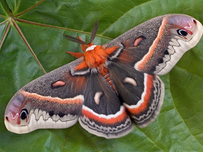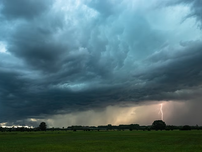top of page
All Posts


Wolves, bears, elk were once common across Illinois
Hundreds of years ago, lions, bison, black bears, cougars, elks, gray wolves and porcupines use to roam modern day Illinois. However, as land use in the state began to change during the 1800s, so did the plants and animals that lived here. Prairies and forests were replaced with agricultural fields causing animals to move to more suitable habitats while others were hunted or driven away.


Light bright: five fun facts about fireflies
Lightning bugs, or fireflies, are a summer favorite, but their numbers are declining due to light pollution, habitat loss, and harvesting for their glow-chemical. Their light helps them find mates, and it’s nearly 100% energy efficient. Not all fireflies glow - some use pheromones to attract mates instead. Only one U.S. species can sync its flashes. Found mostly in the eastern U.S., they’re actually beetles, not flies. You can still catch them - just handle gently and release


Celebrate cecropia moths right in your own yard
The nocturnal cecropia moth, the largest moth in North America, is a lesser-known member of the Lepidoptera family. You can spot them from May to July in busy, urban areas with red and white stripes and crescent-shaped eyespots on their wings; or by their rows of red, yellow, and blue spiny tubercules as caterpillars. Cecropia moths do not eat and are attracted to trees and shrubs that can well-nourish offspring. Adult cecropia moths only live five to six days after emerging


Why do spiders have so many eyes?
The 34,000 species of spiders are categorized based of the number of eyes they have and their arrangement. While most spiders have 8 eyes arranged in pairs, some spiders do not have any eyes and others can have as many as 12. Typically, the most central eyes detect size, shapes, and colors while eyes on the side of their head detect motion. Though some spiders have good vision, most spiders do not and can rely on other senses like taste, touch, and vibration to survive.


5 fun facts about bright and colorful orioles
Baltimore orioles are known for their vibrant plumage and their sweet tooth. They arrive in Illinois in May and migrate south as early as July. Males are black and orange, but females and juvenile males are drabber in color. Orioles eat fruits and insects and build hanging, sock-like nests. They’re not named after Baltimore city, but after England’s Baltimore family, whose crest was similar in color to the orioles’ black-and-orange plumage.


There's plenty of stinkers in the animal kingdom
All animals within the mustelid family, such as skunks, minks, and badgers, can produce bad-smelling secretions. All mustelids have scent glands that can emit secretions with a foul odor that serve different purposes. This secretion can be used to mark territory, attract mates, or as a defense against predators. Other animals outside of the mustelid family and insects with odor-secreting abilities include bombardier beetles, opossums, stink bugs, vultures, and muskrats.


From chucklings to joeys, baby animal names are too cute
Baby animal names can be as adorable as the animals themselves. Some are playful, like porcupette (porcupine), puggle (platypus), and chuckling (woodchuck). Others are cute by sound, like pinkies (rats) and squeaker (dove). Many use suffixes: owlet, snakelet, spiderling, and antling. Unique names include joey (opossum), cygnet (swan), polliwog (frog), wriggler (mosquito larva), and eyas (hawk/falcon).


Why is the grass greener after a storm?
Thunderstorms need two basic things to develop: moisture and quickly rising warm air. Lightning bolts can instantly change nitrogen in the air into a gas that plants can absorb - nitrogen oxide – giving grass its green color. Normally, rain and soil microbes help convert nitrogen for plant use, but lightning speeds up the process. After a storm, especially one with lightning, grass may look noticeably greener. Just remember to observe safely and wait 30 minutes after the stor


These shiny beetles are emerald jewels of the forest
Named for their strong jaws and excellent stalking abilities like a tiger, the six-spotted tiger beetle, Cicindela sexguttata, are diurnal insects that are an emerald green or metallic blue color and have between zero to six white spots on the bottom edges of their forewings, formally known as elytra. Their large eyes give them great peripheral vision, making them hard to catch. Despite their size, they can eat prey larger than them. Six-spotted tiger beetles have a four-stag


Climb on up: Tips for safe tree climbing
Climbing trees is fun and builds strength, confidence, and problem-solving skills. Though some worry it’s risky, injuries are rare with safe practices. Pick strong trees like oaks, avoid damaged ones, and check for wildlife. Dress right, follow safety tips like the rule of three, and only climb trees you can get into and out of on your own. Make sure it’s allowed where you are. Most of all, enjoy the adventure and freedom tree climbing offers.


These busy bees eat holes in your leaves
When we think of bees, honeybees usually come to mind. But Illinois is home to 500 native bee species! One standout is the leafcutter bee, a gentle, solitary yet gregarious pollinator. Using their strong jaws, females cut leaves to build a cozy nest for her eggs. Unlike honeybees, leafcutters drop more pollen, making them 95% effective at pollination. Watch for their powdery yellow abdomens this summer!


Unassuming Dekay's brown snakes are harmless to you
Brown snakes, also called Dekay’s brown snakes, are small, harmless snakes common in Illinois. They live in forests, parks, and even cities, often hiding under leaves or rocks. They eat earthworms, slugs, and snails, and give birth to live young in late summer. Active mostly underground, they use their tongues to “smell” and may flatten their bodies or release a musky odor to scare off predators. You might spot one after a rain when they emerge


Is it OK to leave out nesting material for birds?
Birds use a variety of materials to build nests, from twigs and grass to feathers and bark. It's safe to offer natural nesting materials like sticks, pine needles, and grass clippings—but avoid hazards like human hair, yarn, plastic, dryer lint, and pet fur (if treated with flea meds). Leaving your yard a little untended or putting materials in feeders, shrubs, or even a muddy patch can help nest-builders. Just be sure what you offer is safe and bird-friendly!


Busting myths about the maligned double-crested cormorant
Double-crested cormorants get a bad rap, but they’re fascinating birds! Found in Will County from spring to fall, they have turquoise eyes, bronze wing feathers, and dive to catch fish. They don't steal fish, nor are they up to no good. They’re social, skilled hunters with unique traits like sun-drying wings and toe claws that act as combs. Visit Lake Renwick Preserve to spot them and bust the myths yourself!


Five fun facts about those dandy dandelions
Dandelions are common weeds that benefit lawns by loosening soil and bringing up nutrients. Their greens are nutritious and used in salads, rich in vitamins and iron. Historically, dandelions have medicinal uses for various ailments. They grow almost anywhere, with deep roots and thousands of seeds. The name comes from French, meaning “lion’s tooth,” inspired by jagged leaves. In France, they’re called “pissenlit” due to their diuretic effects.


Windy days are made for play
Windy spring days can be perfect for outdoor fun! Try flying kites, spinning pinwheels, or blowing bubbles. Race clouds, spread seeds like dandelions or milkweed, and listen to how wind sounds in different places. Get creative by building sailboats, making wind chimes, or dancing with homemade streamers. Use the wind to play, explore, and enjoy nature in new ways.


5 fascinating facts about great horned owls
Great horned owls are one of the eight owl species that live in Will County. They have plumicorns, or tufts of feathers, on their head resembling horns or ears. The ability to rotate their necks 270 degrees in either direction makes up for their inability to move their highly sensitive eyes in their sockets. Great horned owls can hear sounds as far as 10 miles away and are almost silent in flight due to their feathers and fringes. They have the most diverse diet of all raptor


Where does dirt come from?
Soil is made of minerals, organic material, air and water and is full of living organisms. It forms very slowly over time, shaped by climate, organisms, landscape, parent material, and time (CLORPT). Particles in dirt are categorized into three groups: clay, sand and silt. Soil varies in texture and color depending on its mineral content. In Illinois, the state soil is Drummer, rich in organic matter from decomposing prairie plants and is found on over 1.5 million acres.


Blast from the past: the underwear of yesteryear
More than 250 years ago, French fur traders and Potawatomi people in Illinois wore very different undergarments - or none at all. Potawatomi wore loincloths or simple skirts with no undergarments. French people wore linen shifts or shirts to absorb sweat and dirt, as they bathed less often. Wealthy individuals had many, others had few. Girls wore layers like petticoats and stays. Laundry was tough, sometimes using stale urine or scrubbing with soap and water!


Five fun facts about those wacky woodpeckers
North America is home to 17 woodpecker species, and seven live in Illinois. Woodpeckers hammer away to search for food, build nesting cavities, and to store their food supply. A woodpecker’s skull is designed to withstand repetitive pecking, and they have long tongues to help them reach for insects in tree bark. Unlike other songbirds, Woodpeckers have a zygodactyl toe that helps them climb and grab onto trees and other structures.
bottom of page